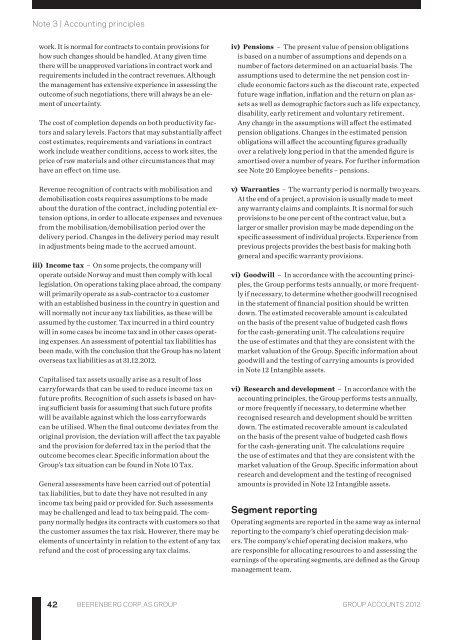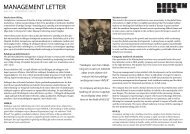Note 1 - Beerenberg
Note 1 - Beerenberg
Note 1 - Beerenberg
Create successful ePaper yourself
Turn your PDF publications into a flip-book with our unique Google optimized e-Paper software.
<strong>Note</strong> 3 | Accounting principles<br />
work. It is normal for contracts to contain provisions for<br />
how such changes should be handled. At any given time<br />
there will be unapproved variations in contract work and<br />
requirements included in the contract revenues. Although<br />
the management has extensive experience in assessing the<br />
outcome of such negotiations, there will always be an element<br />
of uncertainty.<br />
The cost of completion depends on both productivity factors<br />
and salary levels. Factors that may substantially affect<br />
cost estimates, requirements and variations in contract<br />
work include weather conditions, access to work sites, the<br />
price of raw materials and other circumstances that may<br />
have an effect on time use.<br />
Revenue recognition of contracts with mobilisation and<br />
demobilisation costs requires assumptions to be made<br />
about the duration of the contract, including potential extension<br />
options, in order to allocate expenses and revenues<br />
from the mobilisation/demobilisation period over the<br />
delivery period. Changes in the delivery period may result<br />
in adjustments being made to the accrued amount.<br />
iii) Income tax – On some projects, the company will<br />
operate outside Norway and must then comply with local<br />
legislation. On operations taking place abroad, the company<br />
will primarily operate as a sub-contractor to a customer<br />
with an established business in the country in question and<br />
will normally not incur any tax liabilities, as these will be<br />
assumed by the customer. Tax incurred in a third country<br />
will in some cases be income tax and in other cases operating<br />
expenses. An assessment of potential tax liabilities has<br />
been made, with the conclusion that the Group has no latent<br />
overseas tax liabilities as at 31.12.2012.<br />
Capitalised tax assets usually arise as a result of loss<br />
carryforwards that can be used to reduce income tax on<br />
future profits. Recognition of such assets is based on having<br />
sufficient basis for assuming that such future profits<br />
will be available against which the loss carryforwards<br />
can be utilised. When the final outcome deviates from the<br />
original provision, the deviation will affect the tax payable<br />
and the provision for deferred tax in the period that the<br />
outcome becomes clear. Specific information about the<br />
Group’s tax situation can be found in <strong>Note</strong> 10 Tax.<br />
General assessments have been carried out of potential<br />
tax liabilities, but to date they have not resulted in any<br />
income tax being paid or provided for. Such assessments<br />
may be challenged and lead to tax being paid. The company<br />
normally hedges its contracts with customers so that<br />
the customer assumes the tax risk. However, there may be<br />
elements of uncertainty in relation to the extent of any tax<br />
refund and the cost of processing any tax claims.<br />
iv) Pensions – The present value of pension obligations<br />
is based on a number of assumptions and depends on a<br />
number of factors determined on an actuarial basis. The<br />
assumptions used to determine the net pension cost include<br />
economic factors such as the discount rate, expected<br />
future wage inflation, inflation and the return on plan assets<br />
as well as demographic factors such as life expectancy,<br />
disability, early retirement and voluntary retirement.<br />
Any change in the assumptions will affect the estimated<br />
pension obligations. Changes in the estimated pension<br />
obligations will affect the accounting figures gradually<br />
over a relatively long period in that the amended figure is<br />
amortised over a number of years. For further information<br />
see <strong>Note</strong> 20 Employee benefits – pensions.<br />
v) Warranties – The warranty period is normally two years.<br />
At the end of a project, a provision is usually made to meet<br />
any warranty claims and complaints. It is normal for such<br />
provisions to be one per cent of the contract value, but a<br />
larger or smaller provision may be made depending on the<br />
specific assessment of individual projects. Experience from<br />
previous projects provides the best basis for making both<br />
general and specific warranty provisions.<br />
vi) Goodwill – In accordance with the accounting principles,<br />
the Group performs tests annually, or more frequently<br />
if necessary, to determine whether goodwill recognised<br />
in the statement of financial position should be written<br />
down. The estimated recoverable amount is calculated<br />
on the basis of the present value of budgeted cash flows<br />
for the cash-generating unit. The calculations require<br />
the use of estimates and that they are consistent with the<br />
market valuation of the Group. Specific information about<br />
goodwill and the testing of carrying amounts is provided<br />
in <strong>Note</strong> 12 Intangible assets.<br />
vi) Research and development – In accordance with the<br />
accounting principles, the Group performs tests annually,<br />
or more frequently if necessary, to determine whether<br />
recognised research and development should be written<br />
down. The estimated recoverable amount is calculated<br />
on the basis of the present value of budgeted cash flows<br />
for the cash-generating unit. The calculations require<br />
the use of estimates and that they are consistent with the<br />
market valuation of the Group. Specific information about<br />
research and development and the testing of recognised<br />
amounts is provided in <strong>Note</strong> 12 Intangible assets.<br />
Segment reporting<br />
Operating segments are reported in the same way as internal<br />
reporting to the company’s chief operating decision makers.<br />
The company’s chief operating decision makers, who<br />
are responsible for allocating resources to and assessing the<br />
earnings of the operating segments, are defined as the Group<br />
management team.<br />
42<br />
<strong>Beerenberg</strong> CORP. AS Group group accounts 2012












